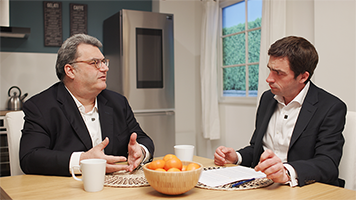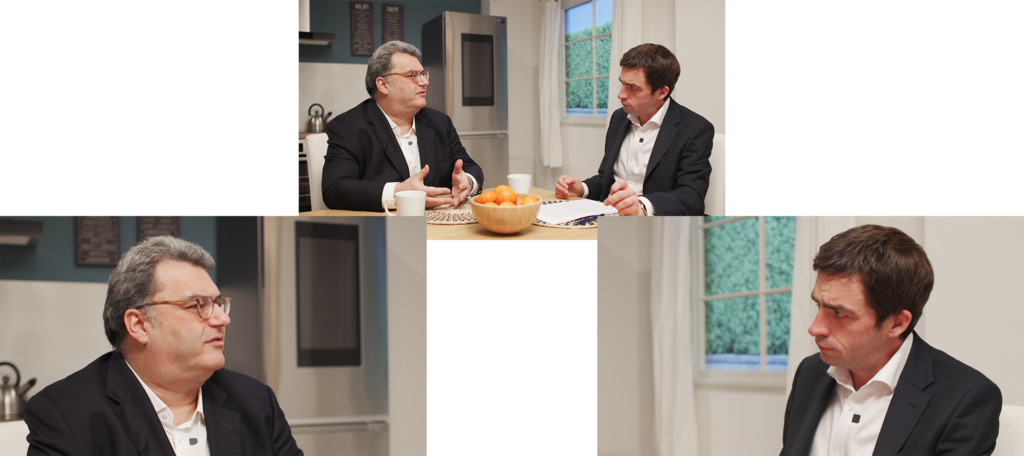Kantar wanted to introduce their new CEO to their staff, and asked us to film an in-conversation video to do so. These are a form of thought leadership film, where two people sit down and chat on camera. Typically, the host introduces the guest, and then they cover agreed topics. At the end, the host thanks the guest, and wraps up.
Tips for Hosts of an In-Conversation Video
Practical tips
- Prepare your introduction in advance, making sure you give the reason for the conversation, and how you’re going to introduce the person
- Look into the camera and hold your gaze into the camera for a second or two with a gentle resting smile. This is to allow the editor to get a good clean start to the film.
- Speak as though talking to an individual, rather than a piece of camera kit
- When you introduce them, allow them a little space to say “thanks for having me” before breaking into the first question
- Be mindful as the host to keep your eye contact with the guest right until the end of the question. Sometimes, the host looks down at their notes before the guest has quite finished, so they’re ready to ask the next question. Better to leave a slight pause that can be edited out. So, let the guest finish, keep nodding. Then look down at your questions, return eye contact to the guest and start gently nodding again, then ask the question. The editor will be able to cut straight from one of the end of the answer to the new question seamlessly.
Conversational Tips
- To make the conversation flow more easily, add your own commentary or context to the questions:
“I’m keen to know your thoughts on why…?”
“I know you worked in telecoms previously; how does that influence…?”
“I’ve noticed the market has shift, when do you think this will change…?”
- Likewise, after the answer, don’t just move on to the next question, but add a reaction:
“I hadn’t thought about weather being an influence”
“I’ll remember that next time I have a project like that.”
“I know those in the HR department will be noting that down!”
- Ask questions which really ask for their personal reaction
“What are you most surprised by…”
“Why has this subject intrigued you…?”
- And throw in some questions which generates advice:
“If someone’s just starting out in this field, what would you suggest?”
“This is quite an overwhelming subject, what’s the critical thing most people don’t know?”
“What do you think are the trends we need to be looking out for?”
- Look for spaces you can ‘interrupt’ the guest’s answers, so it feels like conversation, not an interrogation.
- Depending on the content, the host may look to camera and refer to the people watching. This builds the connection between them and the interview.
- Be playful. A few pattern interrupts can help get a laugh from the guest:
“It would be terrible if that happened…” when it’s a desired or positive outcome
Closing up the Conversation
At the end, typically, one of two things will happen at the end of an in-conversation video. Either the host will thank the guest, the guest will thank the host, and we’ll cut with them looking at each other. Or the host will thank the guest, the guest will thank the host, and then the host will give a final sign off to camera, with a call to action. Again, agreeing all this in advance will make it easier.
Camera set up for an two-person interview

Setting up for a two-person interview requires at least two cameras, ideally three. One camera is framed to cover both interviewees. In this shot, the two people will be in profile, as they’re looking towards each other.
The second camera focuses on the guest, to capture what they are saying. The camera can be angle so that we can clearly see their expression as they talk. Sometimes you can see the shoulder of the host in the corner of this shot, as though you’re sat just behind them.
The third camera would be the reverse of the second, with the host in close up. Again, you might see the guest’s shoulder.
Ideally, you should be able to cut a ‘clean’ shot of the host – ie without seeing the guest – nodding and reacting. This is so you can use this shot if you need to cut some of the answer out. And likewise, of the guest nodding and reacting when the host is asking the next question.
Filming in 4K not only offers clarity but also grants the flexibility to crop and select preferred shots during post-production if you are delivering in standard HD. This means if only two cameras are available, you can get the cutaway of the host by cropping the two-shot in camera A.

Of course, the set needs to be beautifully lit, which is a little more complicated than with a single person interview so you need to build in time and budget to cover this. You also need two radio mics, and ideally two rifle mics – belt and braces to make sure everything said is captured.


